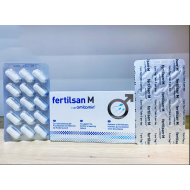
- Stock: In Stock
- Brand: Acme Laboratories Limited
- Product ID: Colecalciferol [Vitamin D3]
100% Secure Payment

Defrol 1000 IU Tablet
Composition
Tablet 1000 IU: Each film-coated tablet contains Cholecalciferol (Vitamin D3) BP 1000 IU.
OFT 2000 IU : Each oroflash tablet contains Cholecalciferol (Vitamin D3) BP 2000 IU.
Capsule 20000 IU : Each capsule contains Cholecalciferol (Vitamin D3) BP 20000 IU.
Capsule 40000 IU : Each capsule contains Cholecalciferol (Vitamin D3) BP 40000 IU.
Syrup : Each 5 ml contains Cholecalciferol (Vitamin D3) BP 1000 IU (equivalent to 25 mcg).
Oral/IM Injectable Solution : Each 1 ml ampoule contains Cholecalciferol (Vitamin D3) BP 200000 IU.
Pharmacology
The active form of Vitamin D3 calcitriol, exerts its effect by binding to the Vitamin D receptors (VDRs) which are widely distributed through many body tissues. Vitamin D3 is absorbed in the small intestine and bound to specific-globulins and transported to the liver where it is metabolised to 25-hydroxy Vitamin D3 (calcidiol). A second hydroxylation
to 1,25-dihydroxy Vitamin D3 (calcitriol) occurs in the kidney. This metabolite is responsible for the vitamins ability to increase the absorption of calcium. Non-metabolised Vitamin
D3 is stored in tissues such as fat and muscle. Vitamin D3 is eliminated via faeces and urine.
Indications
Rickets, osteomalacia and osteoporosis, preeclampsia, prediabetes.
Dosage and Administration
Rout of administration : Oral.
For Tablet :
1000 IU (1-2 tablets) daily, or as directed by physician. Take the medicine with food or within 1 hour after a meal.
For OFT:
2000 IU (1 tablet) daily, or as directed by physician. Take the medicine with food or within 1 hour after a meal.
For Capsule :
Adults :
Treatment of Cholecalciferol deficiency : 40,000 IU/week for 7 weeks, followed by maintenance therapy (1400-2000 IU/day).
Prevention of Vitamin D deficiency : 20,000 IU/month.
Children :
Treatment of Vitamin D deficiency, 12-18 years : 20,000 IU, once every 2 weeks for 6 weeks.
Prevention of Vitamin D deficiency : 12-18 years : 20,000 IU, once every 6 weeks.
For Syrup :
• For patients with risk of Cholecalciferol deficiency: 0-1 yr : 400 IU/ day (2 ml), >1 Yr : 600 lU/ day (3 ml)
• For Cholecalciferol deficient patients: 0-1 yr : 2000 IU/ day (+50000 IU/week ) for 6 weeks, 1 -18 yrs: 2000 IU/ day for 6 weeks.
For Oral/IM Injectable Solution : Rout of administration : By oral or Intramuscular Injection
Prevention: Infants receiving Vitamin D enriched milk: ½ ampoule(0.5ml) i.e. 100000 IU every 6 months. Nursed infants or infants not receiving Vitamin D enriched milk or young children up to 5 years of age : 1 ampoule (1ml) i.e. 200000 I.U. every 6 months.
Adolescents: 1ampoule (1ml) i.e. 200000 IU every 6 months during winter. Pregnancy: ½ ampoule(0.5ml) i.e. 100000 IU from the 6th or 7th month of pregnancy. Elderly: ½ ampoule (0.5ml) i.e.100000 IU every 3months. Digestive disorders, concomitant treatment with antiepileptics & other particular condition not described above ; ½
ampoule (0.5ml) i.e. 100000 IU or 1 ampoule (1ml) i.e. 200000 IU every 3 or 6 months.
Vitamin D deficiency: 1ampoule (1ml) i.e. 200000 IU which can be repeated 1 to 6 months later.
OR AS DIRECTED BY THE PHYSICIAN.
Contraindications
Vitamin D3 is contraindicated in all diseases associated with hypercalcaemia. It is also contraindicated in patients with known hypersensitivity to Vitamin D3 or any of the components of the products. It is aslo contraindicated in severe renal impairment,
Hypervitaminosis D, Nephrotithiasis.
Warning & Precautions
Plasma-calcium concentration should be monitored at intervals in patients receiving high doses of Vitamin D3 in renal impairment, and during pregnancy & lactation. People using digoxin and thiazide diuretics should consult a health care practitioner before supplementing with Vitamin D3. People with liver or kidney disease, primary hyperthyroidism, lymphoma, tuberculosis and granulomatous disease should consult a health care practitioner before supplementing with Vitamin D3.
Side effects
Common side effects : Occasional acute symptoms include anorexia, lassitude, nausea & vomiting, diarrhea, constipation, weight loss, polyuria, sweating, headache, thirst, vertigo, and raised concentrations of calcium and phosphate in plasma and urine.
Rare side effects : Dry mouth, Headache, Weakness and lack of energy.
Use in Pregnancy & Lactation
Pregnancy: Vitamin D3 needs are increased during pregnancy. Vitamin D3 deficiency during pregnancy can affect bone development and immune function from birth through adulthood.
Low Vitamin D3 levels are common among those taking a standard prenatal multivitamin, which usually contains 400 IU, but is inadequate for pregnant women. Even 800 IU of
Vitamin D3 per day didn’t permit most pregnant women to reach a normal Vitamin D3 level. A recently completed study funded by the National Institutes of Health tested the safety and effectiveness of 4000 IU Vitamin D3 per day in pregnant women. The researchers reported that this dose was safe and effective in achieving normal Vitamin D3 levels and resulted in fewer pregnancy complications (infections, preterm labor, birth, and pre-eclampsia) when compared with 400 IU Vitamin D3 per day.
Lactation: It should be assumed that exogenous Vitamin D3 passes into the breast milk. In view of the potential for hypercalcaemia in the mother and for adverse reactions from Vitamin
D3 in nursing infants, mothers may breastfeed while taking Vitamin D3, provided that the
serum calcium levels of the mother and infant are monitored. The American Academy of Pediatrics (AAP) currently recommends that breastfeed infants receiving a supplement of
Vitamin D3 every day prevent Vitamin D3 deficiency and rickets.
Use in children & adolescents
There is no doubt that severe vitamin D deficiency leads to rickets in childhood and adolescence.
Drug Interactions
With medicine : Vitamin D3 interact with antacids (magnesium-containing), phenytoin, phenobarbital, cholestyramine, cholestipol, digoxin, thiazide diuretics. Many drugs cause
Vitamin D3 deficiencies because they interfere with the absorption and metabolism of
Vitamin D3 and includes cholestyramine, cholistipol, phenytoin, phenobarbital, orlistat, and mineral oil. Also, corticosteroids, such as prednisolone increase the need for Vitamin D3. Cholecalciferol is known to interact with Carbamazepine, Dactinomycin, Diuretics, Fosphenytoin, Miconazole, Phenobarbital, Phenytoin, Primidone. With food & others : Avoid alcohol or tobacco consumption while taking vitamin D3 because they can decrease its absorption.
Over dose
Symptoms: anorexia, vomiting, constipation, dystrophy, possibly fever with thirst, polyuria, apathy, hypercalcaemia . Storage Store below 300 C temperature and dry place, protected from light. Keep all medicines out of reach of children.
Packing
Tablet 1000 IU : Each box contains 3 x 10 tablets in blister strips.
OFT 2000 IU : Each box contains 3 x 10 oroflash tablets in blister strips.
Capsule 20000 IU : Each box contains 1 x 10 capsules in blister strips.
Capsule 40000 IU : Each box contains 1 x 10 capsules in blister strips.
Syrup : Each box contains 100 ml syrup in PET bottle and a calibrated dropper




















%20Pvt.%20Ltd./Movicol-Oral-Powder-190x190.jpg)
